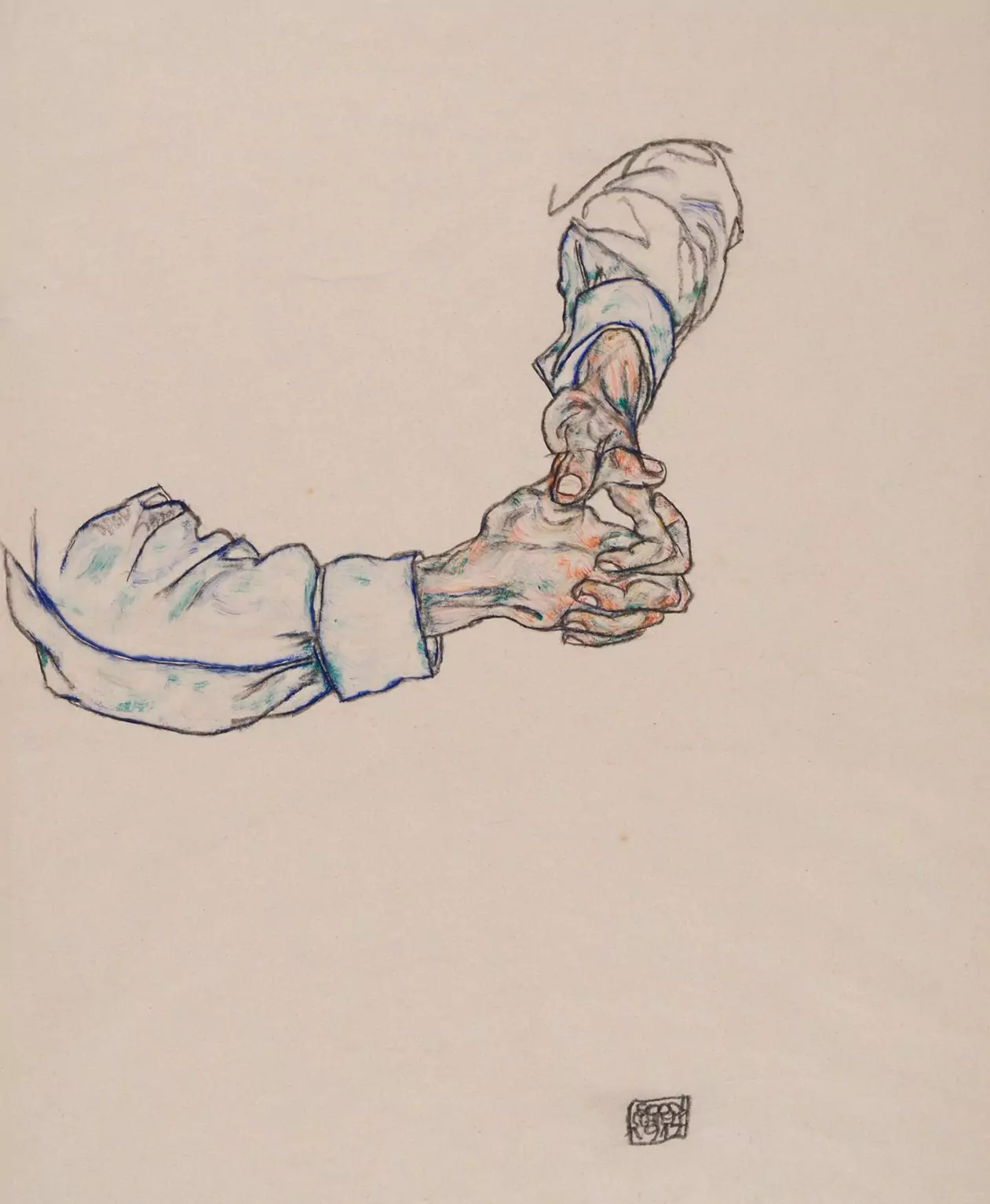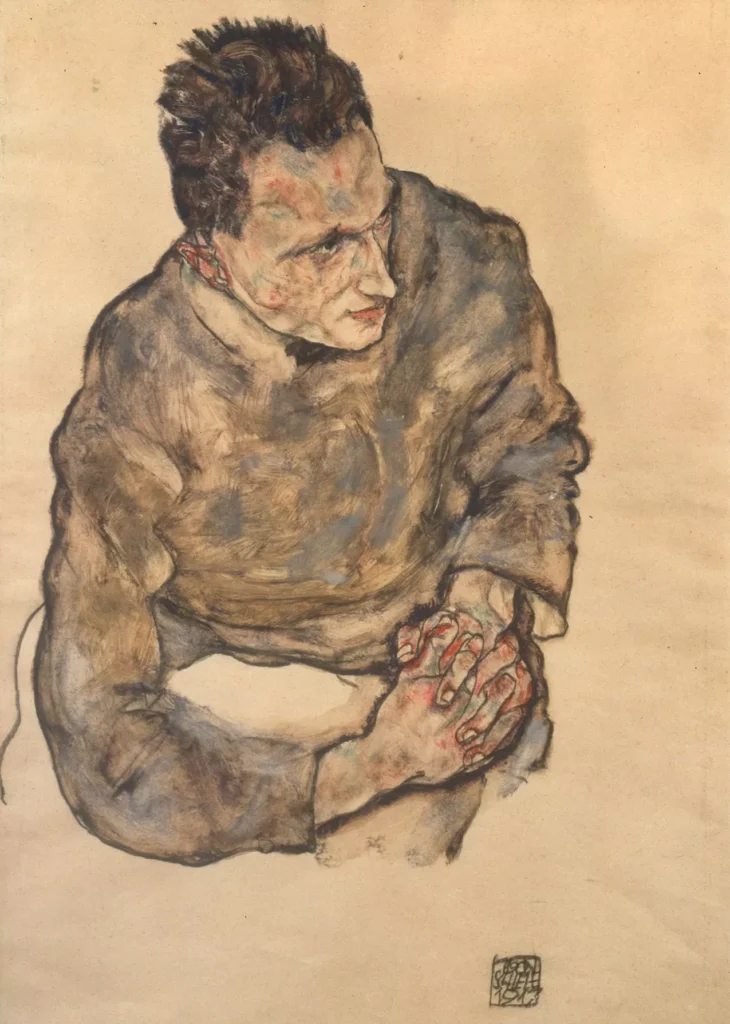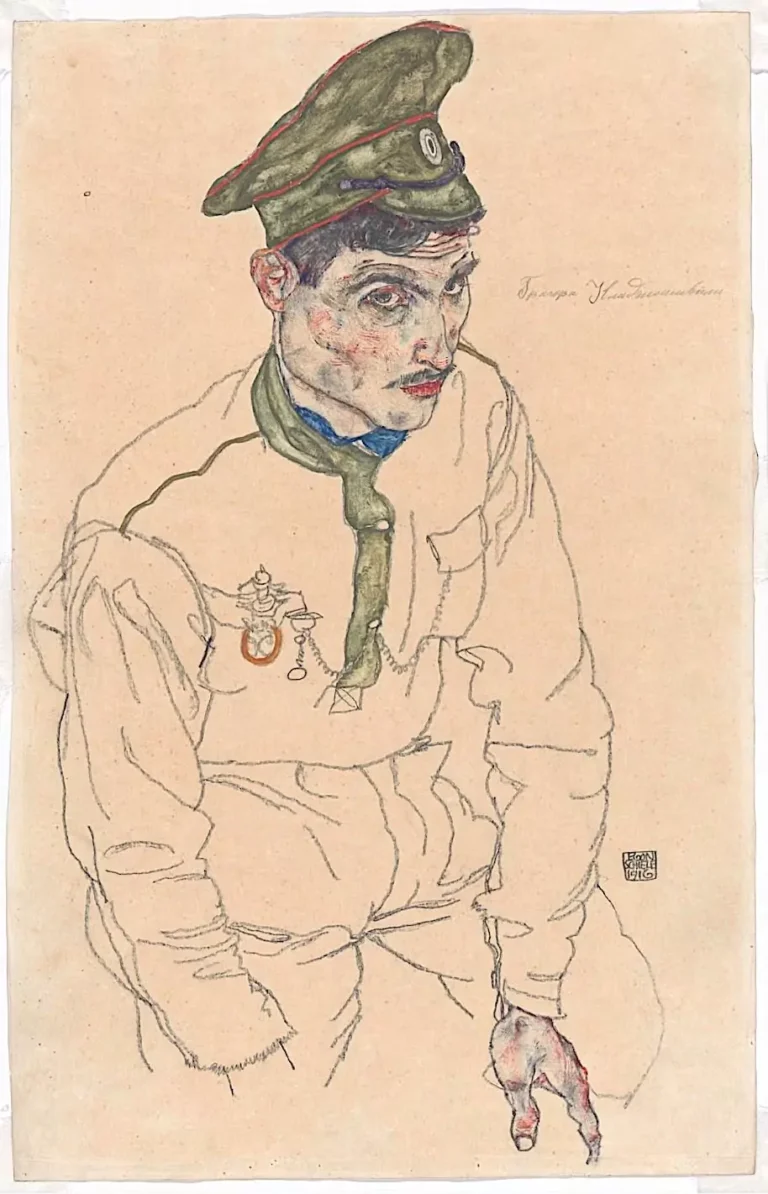Looking for a muse? Check no further. Discover the Best of Art, Culture, History & Beyond!

Egon Schiele is perhaps best known for his provocative and emotionally charged depictions of the human form, especially in his figure studies and portraits. While much attention is often given to his controversial nudes and expressive use of line, Schiele’s attention to seemingly smaller details – like the positioning of hands – reveals the depth of his psychological insight. In Schiele’s art, hands are more than mere anatomical studies; they are vehicles for expression, emotion, and personal narrative. This article delves into one such example: Hand Study (Karl Grünwald), 1917, a gouache and pencil on paper study that offers a fascinating glimpse into both the subject and the artist’s relationship.
A Window to the Soul
The human hand, in Schiele’s art, is a constant motif. It holds a unique position in his visual language, often carrying symbolic weight. As an artist, Schiele was less interested in idealized forms and more focused on conveying raw emotional states. His use of the hand as a vehicle for expression is an essential part of this exploration. In many of his works, the hands of his subjects are distorted, exaggerated, or placed in unnatural positions to evoke specific psychological or emotional undercurrents. The dramatic lines and angular shapes that Schiele employs in depicting hands serve as shorthand for a range of human emotions—grief, anxiety, desire, and even empowerment.
Who Was Karl Grünwald?
To fully appreciate the significance of Hand Study (Karl Grünwald), it is important to understand the man behind the study: Karl Grünwald. A young art dealer, Grünwald was also Schiele’s superior officer in the Austrian army during World War I. At the time of their meeting, Schiele was caught in the turmoil of the war, having been sent to a prisoner-of-war camp in Mühling, Austria. This was a difficult period in Schiele’s life, both personally and professionally. However, Grünwald’s intervention would have a profound effect on Schiele’s trajectory.
Grünwald was instrumental in securing Schiele a transfer from the POW camp to Vienna’s Military Supply Depot in early 1917. This move gave Schiele a renewed sense of freedom, particularly in his artistic pursuits. Rather than being confined to the grim realities of a prison camp, Schiele was now able to cultivate his artistic career with more independence. The Hand Study and its accompanying portrait of Grünwald, painted later that same year, can be interpreted as a token of gratitude from Schiele to Grünwald for his assistance in securing that freedom.
Their relationship was not just one of art dealer and artist but also that of benefactor and beneficiary. It’s important to note that this was a time of great personal hardship for Schiele, yet he found the opportunity to give back through his work, creating both a study of Grünwald’s hands and a more formal oil portrait of him.

Egon Schiele’s Hand Study (Karl Grünwald), while ostensibly a preparatory study, holds far more than a functional purpose. The composition of the hands within the work speaks volumes about Schiele’s approach to the human form and the emotional weight he sought to capture in his subjects. Schiele’s mastery over his medium is evident here, as he combines gouache and pencil on paper with his characteristic flair, rendering the hands with sharp, angular lines that seem to vibrate with energy.
In many of Schiele’s works, hands are not only a signifier of character, but a reflection of power dynamics. This is particularly apparent in the Hand Study of Grünwald, where the positioning of the hands suggests a quiet strength and, perhaps, a sense of duty and control. Schiele’s use of the hand study as a preliminary sketch for a full portrait indicates the care with which he selected each detail. Hands were a central feature in the portrait of Grünwald that followed, where their proportions and positioning again spoke to the psychological depth of the subject.
The Portrait of Karl Grünwald: A Token of Gratitude
In Schiele’s later oil portrait of Karl Grünwald, painted in 1917, we see how Schiele continued to explore the psychological depth of his subject. The Portrait of Karl Grünwald takes on a more formal tone than the Hand Study but retains the emotional intensity that marks Schiele’s best works. In this portrait, Schiele’s treatment of Grünwald’s hands takes on greater prominence, framed by the subject’s sharp features and angular pose.
Schiele’s focus on hands in both works—a study and a full portrait—is not incidental. The artist clearly understood the power of the human hand as an emotional signifier, and his study of Grünwald’s hands serves as a pivotal means of creating a deeper, more nuanced portrait of the man. Schiele often used portraits as a way of reflecting not only the physical likeness of his subjects but also their inner worlds. The study of hands allows him to achieve a psychological reading of his subject that goes beyond surface appearances.
The fact that Schiele rendered Grünwald in both the Hand Study and the later Portrait suggests a deeper connection between the artist and the subject, as if Schiele were honoring the man who had helped him during a particularly challenging time in his life. It also serves as an acknowledgment of Grünwald’s role in Schiele’s artistic freedom. The hands, as seen in the study, are emblematic of the complexities of their relationship.
Egon Schiele’s Hand Study (Karl Grünwald) offers a compelling exploration of how a seemingly small detail in a portrait can reveal much about the subject, the artist, and their relationship. Schiele’s hands are not just anatomical features; they are expressive elements that allow him to create a profound psychological portrait. Through these studies, Schiele demonstrates his mastery not only of the human figure but also of the ways in which gesture and positioning can convey mood, emotion, and character.
In the case of Hand Study (Karl Grünwald), the hands transcend their role as simple preparatory sketches. They become an integral part of the emotional landscape of the work, offering a silent narrative that speaks volumes. This study, alongside its accompanying portrait, showcases Schiele’s unparalleled ability to use the human form to explore the depths of human psychology. For Schiele, hands were not merely tools of function—they were a means of communication, offering insight into the emotional world of the subject.

This article is published on ArtAddict Galleria, where we explore the intersections of art, history, and culture. Stay tuned for more insights and discoveries!

